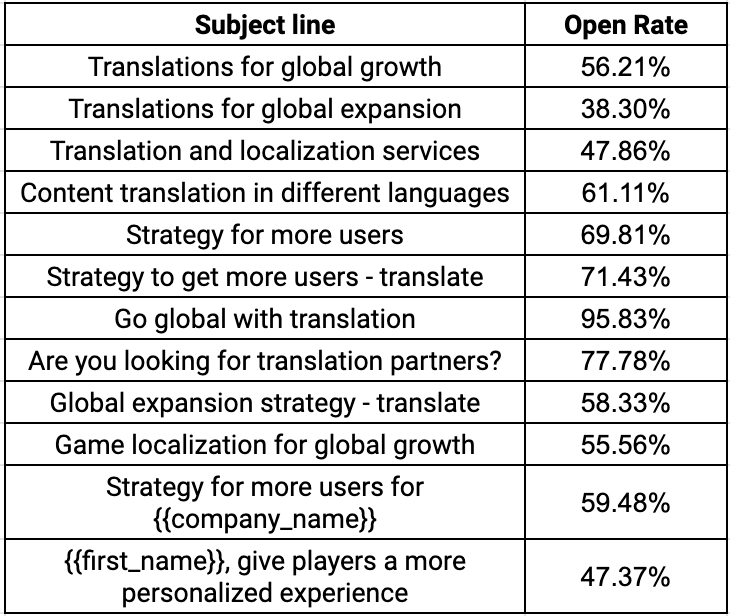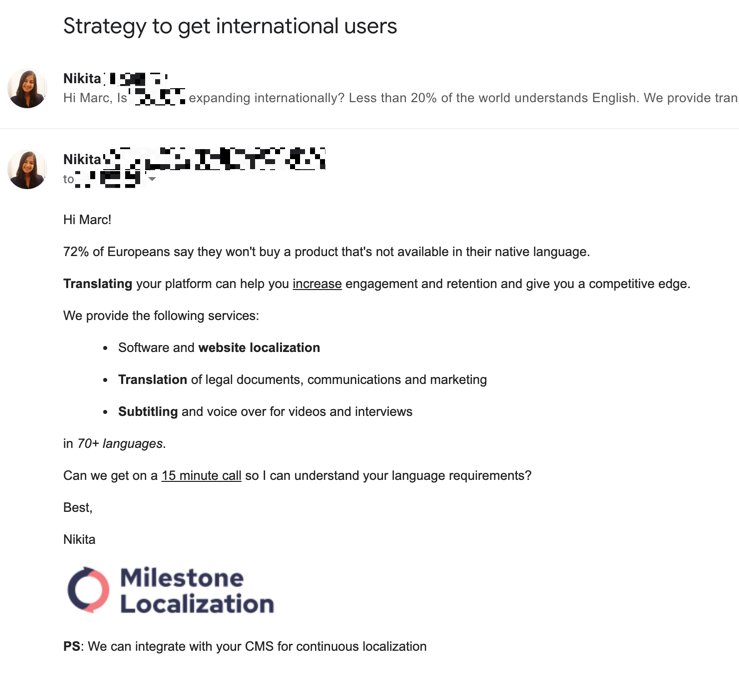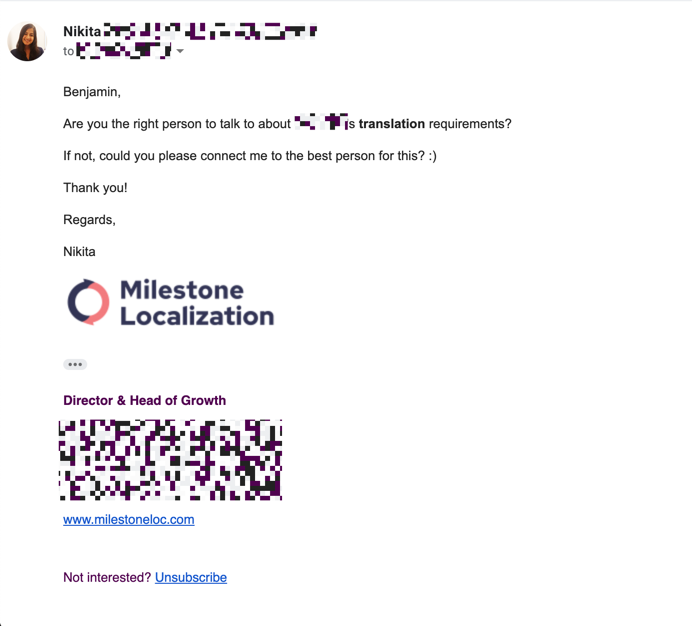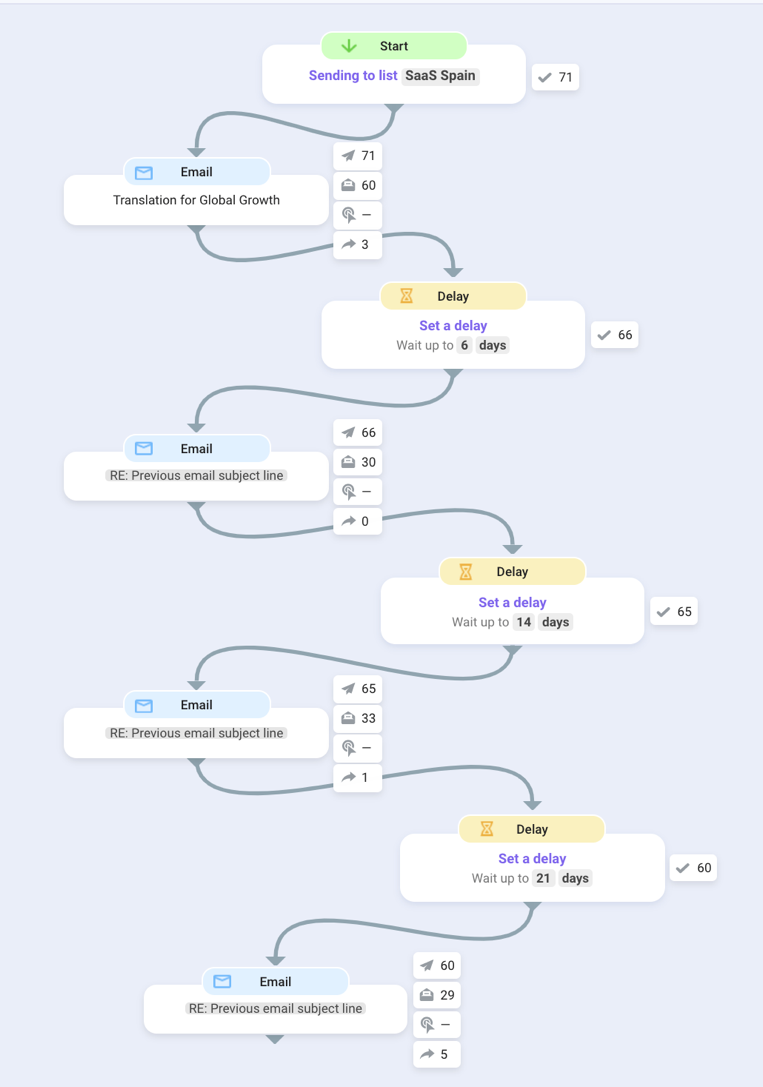
By Nikita Agarwal · June 2, 2021
In May of last year, I started a business, Milestone Localization. We provide translation and localization services to companies looking to expand globally so they can communicate and create connections with non-English-speaking customers.
Initially, we only focused on LinkedIn outreach, sending emails to friends-of-friends and colleagues-of-colleagues. The responses were generally the same: their projects are on hold, they’d keep us in mind if something came up, and so on.
At the time, I was reading all sorts of books on sales and marketing, and I picked up Sell Like Crazy: How to Get As Many Clients, Customers and Sales As You Can Possibly Handle by Sabri Suby. In it, he swears by email as a sales tool.
I decided to give it a shot: we started sending out cold emails.
Our first campaign was sent to mobile gaming companies in the U.S.—we got opens and some clicks but no responses. Our second campaign was to fintech startups in India. We got seven responses, booked four meetings, and landed our first client from outside our peer network. Since then, we’ve booked 250 meetings and landed 42 enterprise clients from different parts of the world—all through cold outreach.
In the last year, I’ve sent out 221 cold outreach email campaigns to 26,962 people across industries and geographies. Here are the five strategies that helped me increase open rates and get more replies.
1. Create your own email lists
Never buy email lists. There are plenty of reasons for this, but the main one is that they won’t target the right buyer profile for your product or service. You only want to send emails to the right person at the right type of company.
For example, if you sell testing software for recruiting factory workers, you would reach out to the head of HR at a mid-size or large manufacturing, transportation, or retail company. If you offer copywriting services for tech audiences, you’d reach out to the head of marketing or content at SaaS companies. In our case, we’d reach out to people in global positions, marketing positions, and product positions who have content they might need translated.
This can be a time-consuming process, depending on how many people you plan to email. You need to:
-
identify the type of company that meets the criteria,
-
identify the role of the person you should contact,
-
go on LinkedIn and find the profiles of the right people at those companies,
-
and find their email addresses.
We have a full-time, in-house position for lead generation, and we use Snov.io, Hunter, and Apollo to help with the process. With that, we get around 90 verified email addresses a day for our campaigns.
If you can’t hire someone full-time, you can always work with freelancers or hire someone for a short-term contract. There are dedicated lead generation experts with the tools and experience to build a solid email list for you—just make sure you give them clear and detailed instructions.
2. Use sentence case (and approachable language) in your subject line
The subject line is the most important part of your email. You can write a perfect email and add the perfect CTA, but it will all be in vain if people don’t open your email.
The average email open rate across industries in 2020 was 18%, and our average email open rate last year was 58%—we attribute this to our subject line strategy.
When you’re writing, ask yourself this: would you send an email with this subject to a friend or colleague? For example: Would you write any of these to someone you personally know?
-
Special Offer For Summer 20% Off
-
Steve, I Can Help You Increase Sales
-
Are You Looking For SEO Services
These are obviously promotional and go straight to trash—or worse, get marked as spam. Here’s a better way to write them:
-
There’s 20% off for the summer
-
Strategy to increase sales
-
SEO services
Here’s the checklist we use for writing a subject line:
-
Is it in sentence case?
-
Does it reflect the actual content of the email?
-
If you got this in your inbox, would you send it straight to trash?
-
Does it sound like it could be from a friend or colleague?
There are a lot of articles that suggest that subject line length and personalization also affect open rates—and that may be true—but we haven’t observed anything notable in relation to these factors.
Here are some subject lines we’ve used in our campaigns along with the open rates for each.

Of course, open rates depend on a number of things: sender name, relevance to receiver, company email filters, attachments in the email, and more. But subject line is an easy one to control. The best way to find what works best for your business is to aggressively A/B test and record the results. Once you find a strategy that works, stick to it.
3. Add a P.S. at the bottom of your email
Lots of people receiving a cold email will scroll down to the signature first to see the sender’s name and company. This makes the space around your signature prime real estate in the cold email world. It could either be the first thing a prospective customer reads, or the last. Either way, you want to make a good impression.
We found that the best way to take advantage of this is to add a “P.S.” right before or after the signature.

Here are some examples of lines we’ve used:
-
P.S. Most companies see ROI on localization in less than 4 months!
-
P.S. Hindi will be the biggest language on the Indian internet by 2022.
-
P.S. 62% of European consumers said they wouldn’t shop on a website that wasn’t available in their language.
-
P.S. We helped [company name in the same industry] translate their app into 7 languages in 3 weeks. We can do the same for [receiver’s company name].
Here are our rules for crafting these extra lines:
-
P.S. is always bold so it stands out.
-
It’s never longer than two lines, and ideally only one.
-
The message is consistent with the email body.
-
The P.S. is interesting—if someone reads this part first, they should want to read the rest of the email.
-
Use statistics or facts if appropriate.
We usually do four-to-five-email drip campaigns, and at least three of them have a P.S. at the end. And how do we know the P.S. works? We’ve received responses directly referencing its contents.
4. Include and highlight a simple CTA at the end
The basic goal of B2B email campaigns should just be to get a response from the prospective customer.
A lot of companies try to get readers to take big steps after reading one email. I’ve seen companies add calls to action (CTAs) like “Start your free trial,” “Book a demo,” and “Schedule a 30-minute call” at the end of emails.
These might get you a few conversions if you’re lucky. But if the recipient has never heard of your company or service, they’re unlikely to make this kind of commitment after reading an email or two. You want to make it as easy as possible for the reader to take the next step. That’s why we use extremely simple, low-commitment CTAs for most of our emails.
Here are some examples that we’ve used:
-
If you’re interested, just reply to this email, and I’ll send you more information.
-
If you’re looking for language services, just reply, and we can schedule a call.
-
If you want to know more, we can get on a 15-minute call.
-
Would you like me to send you a case study?
In a four-to-five-email sequence, two or three will have a simple CTA just asking for a reply. One or two will ask for a call. And the last email in the sequence will always ask the following: “Are you the right person to speak to about [company name]’s language requirements? If not, could you please connect me to the best person? 🙂 Thanks!”

More than 90% of the replies we get consist of people asking for more information. Once in a while, someone will want to book a meeting right away.
That last email has the highest response rate for us—usually between 3-4%. Sometimes they tell us they’re not looking for translation services (which is helpful to know) or that they’re not the right person (also helpful). And every so often, someone connects us to the right person.
5. Send a sequence of emails
If you work in sales, you’ve heard this a million times: the money is in the follow-up.
Just because a prospect doesn’t reply to your first email, that doesn’t mean they’re not interested. They might have missed your email, been too busy to reply, left their reply in drafts, made a note to come back to it later and forgotten—you get the drift.
Most email marketing gurus recommend anywhere between three and six follow-up emails. Our email drip campaigns include either four or five emails spaced out over a period of two-and-a-half to three months. This is what our typical drip sequence looks like:

Most email marketing software allows you to customize your follow-ups and send them only to people who clicked your links or opened your email, for example. We use “Re: [subject line]” for our follow-ups, but you can also write new subject lines for each email. And our process is set up to stop sending messages to a recipient who replies or unsubscribes.
Here are the numbers we saw for the above drip campaign:

You can see here that we got three replies on our first message and six from follow-up messages. In almost every campaign we’ve run, we’ve gotten more responses from the third, fourth, or fifth emails.
Regardless of your sequence, the only way to efficiently follow up at scale is to automate the process. There are plenty of tools that allow you to set up drip campaigns. We use Snov.io, but you can find a drip marketing tool that meets your team’s budget and goals.
A business of any size in any industry can get results from cold emailing, whether it’s to contact potential clients, partners, investors, or anyone in between.
Learning the tricks of the trade can take a few months, and there’s a steep learning curve and time commitment. But once you find the formula that works for your business, you can generate a steady stream of qualified leads—the dream for any B2B business.
And if you try these strategies and see results, reach out to me on LinkedIn! I love discussing sales marketing hacks with other enthusiasts.
This was a guest post from Nikita Agarwal, Director and Head of Growth at Milestone Localization. Milestone provides translation and localization services in 70+ languages so brands can connect with local audiences in their native language. Services include website and app localization, subtitles and voiceovers for videos, audio transcriptions and translation of legal documents, data and communications. Milestone has offices in the UK and India and works with companies around the world to help them succeed internationally. Want to see your work on the Zapier blog? Read our guidelines, and get in touch.
Related reading:
Get productivity tips delivered straight to your inbox
We’ll email you 1-3 times per week—and never share your information.
Related articles
Improve your productivity automatically. Use Zapier to get your apps working together.












